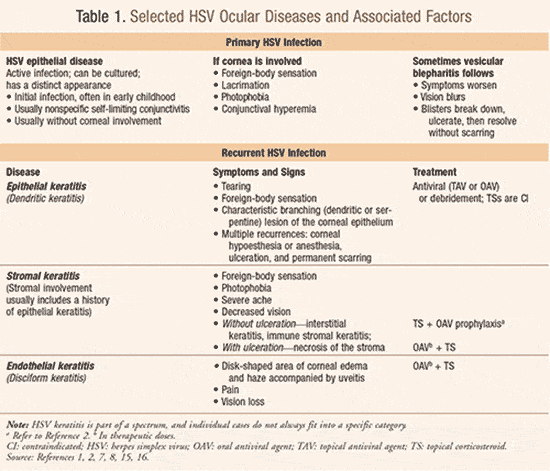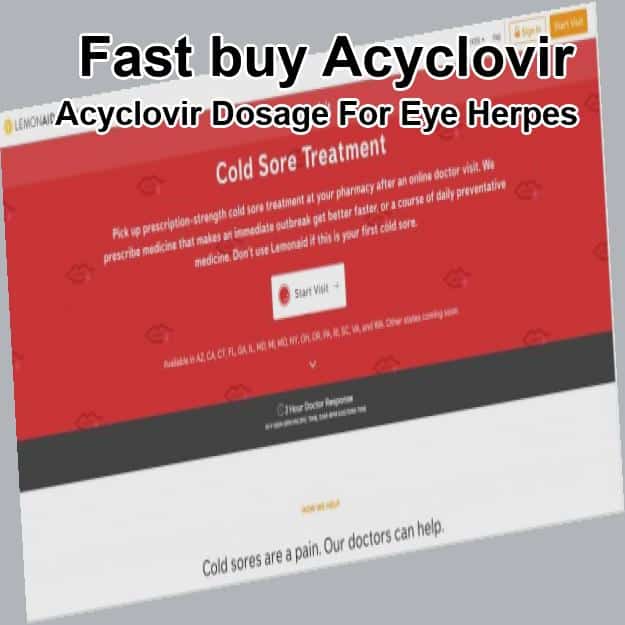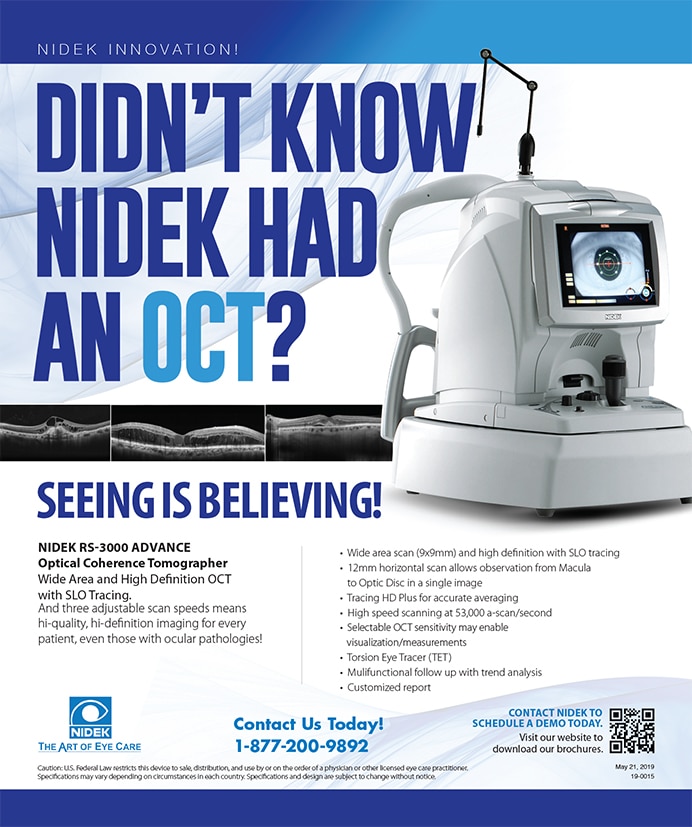History Of Present Illness:
A 36-year-old female presented to the Emergency Treatment Center of the University of Iowa Hospitals and Clinics with one day of right eye pain, photophobia and decreased vision. There was no history of trauma. The ETC physician performed fluorescein staining and made a diagnosis of a corneal abrasion. The patient was treated with topical trimethoprim-polymyxin four times daily and oral acetaminophen-hydrocodone 10/500 as needed for pain relief. She was instructed to follow-up with her eye care provider the next day if symptoms did not improve or resolve.
The following day, her symptoms did not resolve and was therefore referred to the UIHC Cornea service for further evaluation.
Viral Keratitis: Herpes Simplex Virus Type 1 Or 2
Epidemiology
Herpes simplex keratitis has an annual incidence of new cases of 8/10â000. The incidence peaks at ages 5â10 years and 35â40 years. Males are affected twice as often as females. Approximately 50% of patients have a history of herpes labialis. Primary ocular infection occurs in 5%.37
Corneal infection is usually with HSV type 1 , except in neonatal herpes infection, when 80% of cases are due to HSV type 2.
Pathogenesis and Pathology
The pattern of dendritic ulcers is caused by direct infection of corneal epithelium. It is thought that delayed-type hypersensitivity to viral antigens causes the inflammation that leads to disciform keratitis.38 Recurrent HSV keratitis has been described in the course of Alport syndrome.39
Clinical Features
Primary ocular infection is usually asymptomatic, although a vesicular reaction may be seen. Occasionally there is a follicular conjunctivitis. Corneal damage is caused by recurrent disease.
Recurrence occurs in around 10% of cases at 1 year and 50% by 20 years. Triggers include fever, trauma, surgery and ultraviolet light. Recurrence is a consequence of latency.40 Typical presentation is central corneal dendritic ulcers without infiltration easily seen with fluoresÂÂÂceine test. Spread from eye to eye is uncommon except in atopic patients in whom delayed-type hypersensitivity is impaired. These patients are at risk of bilateral disease, larger geographic ulcers and disseminated infection.
Management
Recurrence And Risk Of Vision Loss
The global incidence of HSV keratitis is roughly 1.5 million, including 40,000 new cases of severe monocular visual impairment or blindness, per year.1 HSV keratitis is believed to be an important cause of infectious blindness, with stromal opacification believed to be the main cause.1 Proven triggers for recurrence include ultraviolet light, fever, and refractive surgery.2
Don’t Miss: Can You Get Genital Herpes Medication Over The Counter
Signs Of Herpes Simplex Keratitis
HSK has a highly variable and unpredictable courseCan be considered as a spectrum of four distinct disease entities :
Epithelial Initially punctate lesions, coalescing into dendriform pattern
- dendritic ulcer, single or multiple
- opaque cells arranged in a stellate pattern progressing to a linear branching ulcer terminal bulbs may be visible
- associated with reduced corneal sensitivity
- continued enlargement may result in an amoebic or geographic ulcer
StromalStromal infiltrates, vascularisation, necrosis, scarring, uveitis and keratic precipitates, possibly raised intraocular pressure
Disciform keratitisCentral or eccentric zone of epithelial oedema overlying an area of stromal thickeningFolds in Descemets membrane, uveitis and keratic precipitates
Metaherpetic ulcer Due to a combination of denervation, drug toxicity, persistent defects in epithelial basement membrane
Defining Herpes Simplex Keratitis

Herpes keratitis is referred to as one severe complication associated with HSV . It is generally described as an infection involving the eye/s. This medical condition usually concerns the cornea. Herpes simplex keratitis is treated by means of consuming antiviral drugs. Without proper and immediate medical care, infected individuals will likely lose their vision or eyesight.
From the term keratitis, this condition refers to the inflammation or impairment of the eyes cornea. It usually yields intense pain on the eye/s and can progress from acute to chronic. Since the virus that causes this infection is very common in humans, herpes simplex keratitis is also very likely to occur if no appropriate treatment is administered to stop the virus from corrupting its host.
You May Like: Herpes Outbreak After 10 Years
Slit Lamp Examination/clinical Forms
Herpetic keratitis is usually classified by anatomical localization in regards to affected corneal layers. Although the inflammation process may overlaps different layers. Also, recurrent keratitis is not only limited to one layer and can subsequently affect different corneal parts .
3.2.1 Epithelial keratitis
Figure 1.
Representative images of the slit-lamp photograph of the epithelial HSV keratitis. Central, single dendritic ulcer before and after fluorescein installation. Branches with terminal bulbs visible. Single dendritic ulcer with branches are raised above the corneal surface. Stromal haze accompanying the ulcer is noticeable. Multiple, small dendritic ulcers visible under blue light after fluorescein installation. Geographic, paracentral ulcer visible under blue light after fluorescein installation.
3.2.2 Stromal keratitis
Figure 2.
Representative images of the slit-lamp photograph of eyes with the different involvement of the stromal keratitis or with corneal scars following HSV keratitis. Paracentral stromal infiltration with profound, active limbal vascularization. Epithelial, dendritic ulcer accompanied by active stromal keratitis with vascularization. Central stromal scarring with deep, peripheral vascularization. Stromal haze in the course of recurrent stromal HSV keratitis. Excessive corneal scarring with significant, deep, peripheral vascularization. Significant area of corneal scar accompanied by lipid keratopathy and deep vascularization.
Figure 3.
Clinical Presentation And Diagnosis
Symptoms of HSV keratitis include pain in and around the eye, redness, sensation of a foreign body in the eye, blurred vision, light sensitivity, and watery discharge.8 Characteristic signs include a dendritic corneal lesion or disk-shaped, localized corneal edema and haze plus anterior uveitis .7 Diagnosis of HSV keratitis is confirmed by finding a dendritic ulcer via slit-lamp examination using fluorescein dye if not conclusive, viral culture of the lesion can confirm the diagnosis.7,9,10
You May Like: Can I Die From Herpes
What Are The Signs And Symptoms Of This Condition
The signs and symptoms of this condition depend on the frequency of the infection, whether it be acute or chronic. Additionally, some of these warnings can differ based on primary, as well as recurrent outbreaks. Here are the following signs of illnesses with regards to this life-threatening condition
- Lacrimation abnormal secretion of tears
- discomfort involving the eyes
- Conjunctival hyperemia eye inflammation
These mentioned warnings are recognized as signs of primary illness. Since the impurity does not vanish after a series of treatments, it will reoccur. Consider the following warnings of this condition should the infection reactivates and outbreaks happen again:
- Light sensitivity
It Is Important For Ods To Have A Thorough Understanding Of This Sight
Herpes simplex virus is a major health concern. This is evidenced by the epidemic of genital herpes and the enhanced acquisition of human immunodeficiency virus associated with HSV.1 Its prevalence in the ocular world is just as strong, with HSV keratitis standing as the leading infectious cause of corneal blindness among developed nations, primarily because of its recurrent nature.2 Here, youll find a review of HSVK, including proper differential diagnosis and contemporary antiviral medical management.
| Advanced dendritic lesions during HSV epithelial keratitis can result in geographic ulcers . These defects are more diffuse in appearance, but still maintain branched features along their borders. |
Recommended Reading: Herpes Test Same Day Results
Symptoms Of Herpes Simplex Keratitis
Symptoms of primary herpes simplex eye infections usually resemble those of common conjunctivitis, so the diagnosis of herpes simplex infection is not made.
Symptoms of a reactivation include tearing, redness, a feeling like a foreign object is in the eye , and sensitivity to bright light. Rarely, the infection worsens and the cornea swells, making vision hazy. The more often the infection recurs, the more likely is further damage to the surface of the cornea. Several recurrences may result in the formation of deep ulcers, permanent scarring, blood vessels that grow onto the cornea, and numbness of the eye surface.
With multiple recurrences, the herpes simplex virus can lead to significant visual impairment, which can be permanent.
Priorities Of The Scientific Community
Review of the literature identified nine areas. These nine areas were reworded in plain English for patients: risk factors for recurrence of infection, how quickly the infection can be treated, when there is failure to treat the infection, developing tests to guide our treatment more effectively, uncertainties about disease resistance to treatment, the need for long-term treatment, risk factors for developing infection, impact of the disease on QoL and frequency of hospital visits. The most researched areas were: how quickly the infection can be treated, risk factors for developing infection and when there is failure to treat the infection .
You May Like: How Do They Test For Herpes 2
Causes Of Herpes Simplex Keratitis
With knowledge about the types of this infection, it is safe to say that the first type is the main reason why herpes simplex keratitis happens. The symptoms of the type 1 infection usually appear on the face, such as sores and blisters. When a person touches these sores, from which the eyes are accidentally rubbed, transmission is likely to happen. That is why keeping the hands clean and preventing the activity rubbing the eyes during a herpes outbreak is a must.
Papers Of Particular Interest Published Recently Have Been Highlighted As: Of Importance Of Major Importance

Hartmut Hengel. Common characteristics and distinct features of human pathogenic herpesviruses. In: Rainer Sundmacher, editor. Color atlas of herpetic eye diseases-a practical guide to clinical management. Heidelberg: Springer 2009. p. 14.
Rabenau HF, Buxbaum S, Preiser W, Weber B, Doerr HW. Seroprevalence of herpes simplex virus types 1 and type 2 in the Frankfurt am Main area, Germany. Med Microbiol Immunol. 2002 190:15360.
Don’t Miss: How Long Do Genital Herpes Sores Take To Heal
Current Management Of Herpes Simplex Keratitis
- Interview with
You’ve saved your first item
You can find your saved items on your dashboard, in the “saved” tab.
You’ve recommended your first item
Your recommendations help us improve our content suggestions for you and other PracticeUpdate members.
You’ve subscribed to your first topic alert
What does that mean?
Recent Developments: Newer Drug Formulations And Vaccination
Newer oral antivirals have been made available that simplify the dosing regimen of acyclovir. Valacyclovir and famciclovir act through inhibition of viral DNA polymerase, like acyclovir. Although their efficacy in humans is to be ascertained, convenient twice-a-day dosage has led to their widespread use, despite higher cost.
The use of topical cyclosporine A has been attempted with variable success rates in the management of HSV stromal keratitis. These studies contained small numbers of herpetic eyes, and all lacked a control group .
In a mouse model, vaccination with a mixture of self-adjuvanting lipopeptides containing novel HSV-1 immunodominant gD T-cell epitopes increased protection from ocular herpes infection and disease. But the strength of this protective immunity induced by these lipopeptides together with their safety need to be ascertained to combat ocular herpes infection and disease in humans .
Recommended Reading: How Long After Herpes Outbreak Is It Still Contagious
This Review Can Help You Better Identify Diagnose And Treat This Condition
Herpes Simplex Keratitis: Managing the MasqueraderThis review can help you better identify, diagnose and treat this condition.
Release Date: November 15, 2020Expiration Date: November 15, 2023Estimated time to complete activity: 2 hours
Jointly provided by Postgraduate Institute for Medicine and Review Education Group.
Educational Objectives:After completing this activity, the participant should be better able to:
- Provide a timely diagnosis and initiate the right therapy for patients with herpes simplex keratitis.
- Review the examination and testing steps for herpes simplex keratitis.
- Recognize what signs and symptoms can reveal herpes simplex keratitis as the cause.
- Treat herpes simplex keratitis properly.
- Discuss the long-term prognosis and how clinicians can monitor for recurrence.
Target Audience: This activity is intended for optometrists engaged in the care of patients with herpes simplex keratitis.
Accreditation Statement: In support of improving patient care, this activity has been planned and implemented by the Postgraduate Institute for Medicine and Review Education Group. Postgraduate Institute for Medicine is jointly accredited by the Accreditation Council for Continuing Medical Education, the Accreditation Council for Pharmacy Education, and the American Nurses Credentialing Center, to provide continuing education for the healthcare team. Postgraduate Institute for Medicine is accredited by COPE to provide continuing education to optometrists.
Eye Herpes Vs Conjunctivitis
You may mistake eye herpes for conjunctivitis, which is known more commonly as pink eye. Both conditions may be caused by a virus, though conjunctivitis can also be caused by:
A doctor can make the correct diagnosis using a culture sample. If you have eye herpes, the culture will test positive for type 1 HSV . Receiving a correct diagnosis can help you to receive proper treatment.
Recommended Reading: What To Know About Dating Someone With Herpes
Steroids Play A Role For Treatment In Some Patients
Patients with herpes simplex virus keratitis can present some of the most challenging cases that eye surgeons treat, said Edward J. Holland, M.D., Cincinnati Eye Institute, University of Cincinnati.
Once they delineate the type of HSV keratitis the patient has, clinicians must decide on the most effective use of antiviral medications. This may mean a choice of oral versus topical antiviral medications, combining antivirals with corticosteroids when appropriate, and prescribing antiviral medications as prophylaxis indefinitely or before surgery.
Although some clinicians have clear guidelines as to when to use antiviral or steroid treatment and what type of antiviral or steroid treatment they will use, others still struggle to manage this, said James Chodosh, M.D., professor, Department of Ophthalmology, University of Oklahoma Health Sciences Center, Oklahoma City.
Here are some pros and cons on the use of oral versus topical antivirals for treatment or prophylaxis in patients with HSV keratitisand when it is appropriate to administer corticosteroids.
Preventing Recurrence Of Hsv Keratitis
While there are no proven methods for preventing HSV keratitis, there are steps that can be taken to assist in controlling its recurrences. Patients should be instructed to8,11
Avoid touching the eyes or area around the eyes unless hands have been properly washed, particularly when a herpes infection is present.
Refrain from using eye drops unless they have been prescribed or recommended by an ophthalmologist or other provider.
Habits, supplies, and techniques matter considerably when it comes to the health of the eyes while wearing contact lenses. Tips found in the Resource section can help pharmacists guide patients in the prevention of HSV recurrence by instructing those who wear contact lenses in the proper habits with regard to storage solution, cleaning technique, and replacement of lenses and storage cases.
Don’t Miss: Why Doctors Don’t Test For Herpes
A Review Of Treatment For Herpes Zoster Keratitis
touchREVIEWS in Ophthalmology.
Abstract:
Overview
Herpes zoster keratitis is a common manifestation of the varicella zoster virus. Early in the disease course, the active virus can cause epithelial keratitis, and later in the disease course, an inflammatory response can cause stromal or endothelial keratitis. Complications include ulceration, neurotrophic keratitis and corneal scarring. Treatment for herpes zoster keratitis involves oral antiviral therapy for early manifestations and topical steroids for later manifestations. While antiviral prophylaxis is a topic of active research, vaccination against shingles remains an important part in preventing herpes zoster keratitis.
Keywords
Herpes zoster, herpes zoster ophthalmicus, herpes zoster keratitis, vaccination, Zoster Eye Disease Study
Article:
General presentation and management of herpes zoster ophthalmicus
Oral antiviral treatment options for HZ include 1 g valacyclovir three times daily, 800 mg acyclovir five times daily or 500 mg famciclovir three times daily, with initiation of therapy within 72 hours of symptom onset for a duration of 7â10 days.22â24
Early and late manifestations of herpes zoster keratitis
Complications from herpes zoster keratitis
Chronic and recurrent herpes zoster keratitis
Article Information:
Disclosure
Compliance With Ethics
Review Process
Table 2 Oral Antiviral Therapy Dosing4

Dendritic Epithelial Keratitis Antiviral *Antiviral treatment is prophylactic since patients are also treated with a therapeutic dose of topical steroid. **Limited dose of topical steroid plus therapeutic dose of antiviral.***Therapeutic dose of topical steroid and therapeutic dose of antiviral. Oral antiviral agent is reduced to prophylactic dose after seven to 10 days and maintained as long as steroid is in use.
HSV stromal keratitis without epithelial ulceration is the more common of the two HSV stromal infections. As its name implies, stromal keratitis without ulceration is thought to occur due to viral proteins that remain in the cornea even after the infection has resolved.17 In response to these remaining proteins, the body produces an inflammatory response, which results in a stromal keratitis without necrosis. Patients will generally present with symptoms of blurry vision, photophobia and halos around lights brought on by edema of the stroma.15
Clinical signs include stromal edema, anterior chamber reaction, stromal opacity and neovascularization.13 This significant inflammatory response, in combination with recurrent disease, often makes stromal keratitis the instigator of irreversible damage and significant scarring. Stromal keratitis without ulceration requires the use of a topical corticosteroid along with an oral antiviral.
Read Also: Valtrex Treatment For Oral Herpes
When To Provide Anti
Recurrence
Duration of symptoms in patients with herpes simplex keratitis is reduced with treatment with topical or oral antiviral agents. Immunocompromised patients may require topical and systemic treatment, and longer duration of therapy. A small percentage of patients develop chronic or recurrent inflammation, or recurrent viral keratitis, both of which are treated with prophylactic oral antiviral agents. Some patients also benefit from treatment with topical corticosteroid agents, used in conjunction with antiviral prophylaxis. Fortified topical antibiotics and fluoroquinolones are still the mainstay of bacterial keratitis therapy. Voriconazole may be useful for treating amebal keratitis.
Specific anti-infectious treatment should be prescribed in addition to steroids in case of uveitis, in collaboration with the ophthalmologist and the infectious disease specialist.
Further reading available online atexpertconsult.com.
Sapna Sinha, … L. Jay Katz, in, 2021